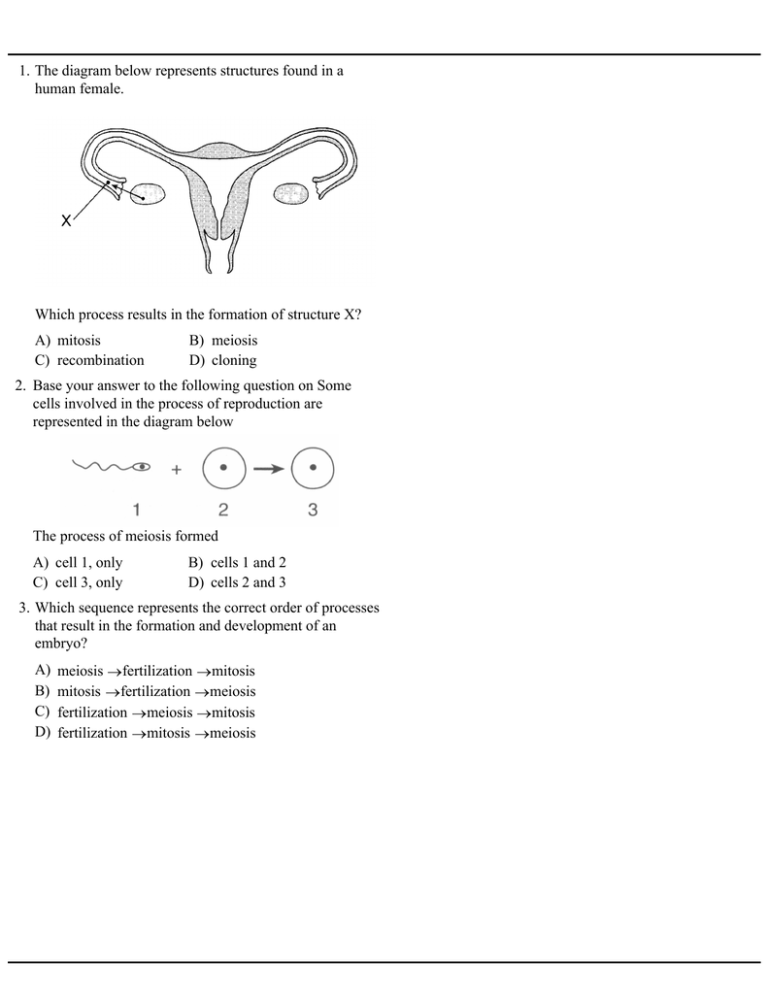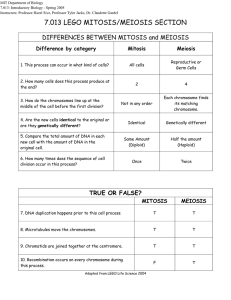1. The diagram below represents structures found in a human female. Which process results in the formation of structure X?
advertisement

1. The diagram below represents structures found in a human female. Which process results in the formation of structure X? A) mitosis C) recombination B) meiosis D) cloning 2. Base your answer to the following question on Some cells involved in the process of reproduction are represented in the diagram below The process of meiosis formed A) cell 1, only C) cell 3, only B) cells 1 and 2 D) cells 2 and 3 3. Which sequence represents the correct order of processes that result in the formation and development of an embryo? A) B) C) D) meiosis ®fertilization ®mitosis mitosis ®fertilization ®meiosis fertilization ®meiosis ®mitosis fertilization ®mitosis ®meiosis 4. Base your answer to the following question on the diagram below and on your knowledge of biology. The diagram represents a single-celled organism, such as an amoeba, undergoing the changes shown. Process 1 is known as A) replication B) meiosis C) differentiation 5. Which statement correctly describes the genetic makeup of the sperm cells produced by a human male? A) Each cell has pairs of chromosomes and the cells are usually genetically identical. B) Each cell has pairs of chromosomes and the cells are usually genetically different. C) Each cell has half the normal number of chromosomes and the cells are usually genetically identical. D) Each cell has half the normal number of chromosomes and the cells are usually genetically different. D) digestion 6. Base your answer to the following question on The diagram below illustrates some of the changes that occur during gamete formation. Which graph best represents the changes in the amount of DNA in one of the cells at each stage? A) B) C) D) 7. Base your answer to the following question on The diagram below represents processes involved in human reproduction. Which row in the chart below correctly identifies the processes represented by the letters in the diagram? A) 1 B) 2 C) 3 D) 4 8. Most cells in the body of a fruit fly contain eight 9. Base your answer to the following question on The chromosomes. In some cells, only four chromosomes are diagram below represents a reproductive process. present. What is this condition a direct result of? A) B) C) D) mitotic cell division meiotic cell division embryonic differentiation internal fertilization The three structures indicated by letter X are known as A) B) C) D) ova embryos polar bodies homologous chromosomes 10. Each body cell of a chimpanzee contains 48 chromosomes. How many chromosomes would normally be present in a gamete produced by this chimpanzee? A) 24 B) 36 C) 48 D) 96 15. Which statement is true of both mitosis and meiosis? A) B) C) D) 11. Sexual reproduction in a species usually results in A) an increase in the chromosome number in the offspring B) offspring genetically identical to the parent C) recombination of genes D) a decrease in biodiversity Both are involved in asexual reproduction. Both occur only in reproductive cells. The number of chromosomes is reduced by half. DNA replication occurs before the division of the nucleus. 16. The number in each circle below represents the chromosome number of the cell. Which diagram represents the production of offspring by an asexually reproducing organism A) 12. Which row in the chart below indicates the correct process for each event indicated? B) A) 1 B) 2 C) 3 D) 4 13. Which two structures of a frog would most likely have the same chromosome number? A) B) C) D) skin cell and fertilized egg cell zygote and sperm cell kidney cell and egg cell liver cell and sperm cell C) D) 14. Which row in the chart below best describes asexual reproduction? 17. Asexually reproducing organisms pass on hereditary information as A) 1 B) 2 C) 3 D) 4 A) B) C) D) sequences of A, T, C, and G chains of complex amino acids folded protein molecules simple inorganic sugars 18. Base your answer to the following question on The diagram below represents chromosomes in a zygote. Which diagrams best illustrate the daughter cells that result from normal mitotic cell division of this zygote? Base your answers to questions 19 and 20 on the diagrams below. 19. Which diagram shows the pairing of homologous chromosomes? A) A A) B) B C) C D) D 20. Which diagram shows the formation of a cell plate? B) D) C) A) A B) B C) C D) D 21. Base your answer to the following question on The diagram below shows two different cells undergoing mitotic cell division. Which statement best describes these cells? A) B) C) D) A and B are different types of animal cells. A and B are different types of plant cells. A is a plant cell and B is an animal cell. A is an animal cell and B is a plant cell.





